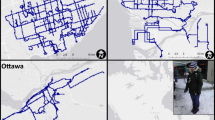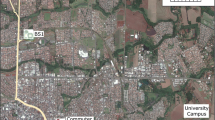Abstract
The chemical characterization of particulate matter inside and outside of confined bus shelters has been discerned for the first time. Transit patrons are at risk due to the close vicinity of densely trafficked areas resulting in elevated pollution footprints. Incomplete combustion processes, as well as exhaust and wear and tear emissions from public and personal transportation vehicles, are key contributors to degraded urban air quality and are often implicated as causal to various diseases in humans. Urban planning, therefore, includes efficient public transport systems to mitigate the effect. The bus rapid transit system was inaugurated in Curitiba to ensure dedicated traffic lanes, major bus interchanges and semi-confined bus stops called “tube stations”. To assess the chemical risk that the passengers are exposed to, an investigation of the aerosol inside and outside five of these tube stations was launched. Electron probe X-ray micro-analysis and X-ray fluorescence were used to determine the elemental composition of individual and of bulk particle samples. An aethalometer quantified the black carbon. Elemental concentrations inside the shelters were in general higher than outside, especially for traffic-related elements. The lead concentration exceeded the NAAS standard at times, although the average was below the guideline. The biogenic, organic and soot clusters showed the highest abundance for the city centre sites. The overall carcinogenic risk could be classed as moderate, and the risk was significant at two sites during one of the sampling campaigns. The non-carcinogenic risk is well below the significant value.







Similar content being viewed by others
References
Aarnio P, Yli-Tuomi T, Kousa A, Mäkelä T, Hirsikko A, Hämeri K, Räisänen M, Hillamo R, Koskentalo T, Jantunen M (2005) The concentrations and composition of and exposure to fine particles (PM2.5) in the Helsinki subway system. Atmospheric Environment 39:5059–5066
Abrahams PW (2002) Soils: their implications to human health. Sci Total Environ 291:1–32
Asmi E, Antola M, Yli-Tuomi T, Jantunen M, Aarnio P, Mäkelä T, Hillamo R, Hämeri K (2009) Driver and passenger exposure to aerosol particles in buses and trams in Helsinki, Finland. Sci Total Environ 407:2860–2867
Avigo D, Godoi AFL, Janissek PR, Makarovska Y, Krata A, Potgieter-Vermaak S, Alfoldy B, Van Grieken R, Godoi RHM (2008) Particulate matter analysis at elementary schools in Curitiba, Brazil. Anal Bioanal Chem 391:1459–1468
Barath S, Mills NL, Lundbäck M, Törnqvist H, Lucking AJ, Langrish JP, Söderberg S, Boman C, Westerholm R, Löndahl J, Donaldson K, Mudway IS, Sandström T, Newby DE, Blomberg A (2010) Impaired vascular function after exposure to diesel exhaust generated at urban transient running conditions. Particle and Fibre Toxicology 7:19
Campos S (2003) As poluições causadas pelos veículos. Revista Medicina Avançada 36
Carter JD, Ghio AJ, Samet JM, Devlin RB (1997) Cytokine production by human airway epithelial cells after exposure to an air pollution particle is metal-dependent. Toxicol Appl Pharmacol 146:180–188
Castanho ADA, Artaxo P (2001) Wintertime and summertime São Paulo aerosol source apportionment study. Atmospheric Environment 35:4889–4902
Cheng YH, Chang HP, Yan JW (2012) Temporal variations in airborne particulate matter levels at an indoor bus terminal and exposure implications for terminal workers. Aerosol and Air Quality Research 12:30–38
Després VR, Huffman JA, Burrows SM, Hoose C, Safatov AS, Buryak G, Fröhlich-Nowoisky J, Elbert W, Andreae MO, Pöschl U, Jaenicke R (2012) Primary biological aerosol particles in the atmosphere: a review. Tellus B 64:15598
Dockery DW, Pope CA, Xu X, Spengler JD, Ware JH, Fay ME, Ferris BGJ, Speizer FE (1993) An association between air pollution and mortality in six US cities. N Engl J Med 329:1753–1759
Godoi RHM, Godoi AFL, Worobiec A, Andrade SJ, Hoog J, Santiago-Silva MR, Van Grieken R (2004) Characterisation of sugar cane combustion particles in the Araraquara region, southeast Brazil. Microchimica Acta 145:53–56
Halonen JI, Lanki T, Yli-Tuomi T, Tiittanen P, Kulmala M, Pekkanen J (2009) Particulate air pollution and acute cardiorespiratory hospital admissions and mortality among the elderly. Epidemiology 20:143–153
Hansen ADA, Rosen H, Novakov T (1984) The aethalometer—and instrument for the real-time measurement of optical absorption by aerosol particles. Sci Total Environ 36:191–196
Hu X, Zhang Y, Luo J, Wang T, Lian H, Ding Z (2011) Bioaccessibility and health risk of arsenic, mercury, and other metals in urban street dusts from a mega-city, Nanjing, China. Environ Pollut 159:1215–1221
John K, Karnae S, Crist K, Kim M, Kulkarni A (2007) Analysis of trace elements and ions in ambient fine particulate matter at three elementary schools in Ohio. Journal of the Air and Waste Management Association 57:394–406
Kooter IM, Van Vugt MATM, Jedynska AD, Tromp PC, Houtzager MMG, Verbeek RP, Kadijk G, Mulderij M, Krul CAM (2011) Toxicological characterization of diesel engine emissions using biodiesel and a closed soot filter. Atmospheric Environment 45:1574–1580
Liu QT, Diamond ML, Gingrich SE, Ondov JM, Maciejczyk P, Stern GA (2003) Accumulation of metals, trace elements, and semi-volatile organic compounds on exterior window surfaces in Baltimore. Environ Pollut 122:51–61
Mason B (1966) Principles of geochemistry. Wiley, New York
Mills NL, Törnqvist H, Robinson SD, Gonzalez M, Darnley K, MacNee W, Boon NA, Donalson K, Blomberg A, Sandström T, Newby DE (2005) Diesel exhaust inhalation causes vascular dysfunction and impaired endogenous fibrinolysis. Circulation 112:3930–3936
Mills NL, Törnqvist H, Gonzalez MC, Vink E, Robinson SD, Söderberg S, Boon NA, Donaldson K, Sandström T, Blomberg A, Newby DE (2007) Ischemic and thrombotic effects of dilute diesel-exhaust inhalation in men with coronary heart disease. N Engl J Med 357:1075–1082
Moore A, Figliozzi M, Monsere CM (2012) Air quality at bus stops, empirical analysis of exposure to particulate matter at bus stop shelters. Journal of the Transportation Research Board 2270:76–86
Moore A, Figliozzi M (2013) A statistical study of the variables associated with particulate matter exposure levels at bus shelters. Journal of the Transportation Research Board.
Pope CA, Dockery DW (2006) Health effects of fine particulate air pollution: lines that connect. Journal of the Air & Waste Management Association 56:709–742
Pope CA, Dockery DW, Schwartz J (1995) Review of epidemiological evidence of health effects of particulate air pollution. Inhal Toxicol 7:1–18
Potgieter-Vermaak S, Van Grieken R, Potgieter JH (2012) Integrated analytical techniques for analysing individual environmental particles, in RSC Specialist Periodical Reviews on “Spectroscopic properties of Inorganics and Materials” Spectroscope. Prop Inorg Organomet Comp 43:123–140
RAIS-A (2013) The Risk Assessment Information System. http://rais.ornl.gov
RAIS-B (2013) RAIS Risk Exposure Models for Chemicals User’s Guide. http://rais.ornl.gov/tools/rais_chemical_risk_guide.html
Salvi S, Blomberg A, Rudell B, Kelly F, Sandström T, Holgate ST, Frew A (1999) Acute inflammatory response in the airways and peripheral blood after short-term exposure to diesel exhaust in healthy human volunteers. Am J Respir Crit Care Med 159:702–709
Sandradewi J, Prévôt ASH, Szidat S, Perron N, Alfarra MR, Lanz VA, Weingartner E, Baltensperger U (2008) Using aerosol light absorption measurements for the quantitative determination of wood burning and traffic emission contributions to particulate matter. Environ Sci Technol 42:3316–3323
Singh M, Jaques PA, Sioutas C (2002) Size distribution and diurnal characteristics of particle-bound metals in source and receptor sites of the Los Angeles Basin. Atmospheric Environment 36:1675–1689
Swietlik R, Molik A, Molenda M, Trojanowska M, Siwiec J (2011) Chromium (III/VI) speciation in urban aerosol. Atmospheric Environment 45:1364
Tortajada JF, García JAO, Andreu L, Castell JG, Vera JA, Conesa AC, García VF (2003) Scholar buses and diesel engines: atmospheric contamination, pediatric exposure and human health adverse effects. Revista Española de Pediatría 59:132–145
Tsang H, Kwok R, Miguel AH (2008) Pedestrian exposure to ultrafine particles in Hong Kong under heavy traffic conditions. Aerosol and Air Quality Research 8:19–27
U.S. Environmental Protection Agency (1990). http://www.epa.gov/air/criteria.html
U.S. Environmental Protection Agency (1989) Risk Assessment Guidance for Superfund Volume I Human Health Evaluation Manual (Part A).
U.S. Environmental Protection Agency (2013) Risk Assessment Guidance for Superfund (RAGS), Volume I: Human Health Evaluation Manual (Part F, Supplemental Guidance for Inhalation Risk Assessment).
Vinzents P, Møller P, Sørensen M, Knudsen L, Hertel O, Jensen F, Schibye B, Loft S (2005) Personal exposure to ultrafine particles and oxidative DNA damage. Environ Heal Perspect 113:1485–1490
World Health Organization (2006) WHO air quality guidelines global updates 2005
Yim SH, Barrett SR (2012) Public health impacts of combustion emissions in the United Kingdom. Environ Sci Technol 46:4291–4296
Yli-Tuomi T, Aarnio P, Pirjola L, Mäkelä T, Hillamo R, Jantunen M (2005) Emissions of fine particles, NOx and CO from on-road vehicles in Finland. Atmospheric Environment 39:6696–6706
Author information
Authors and Affiliations
Corresponding author
Rights and permissions
About this article
Cite this article
Godoi, R.H.M., Godoi, A.F.L., de Quadros, L.C. et al. Risk assessment and spatial chemical variability of PM collected at selected bus stations. Air Qual Atmos Health 6, 725–735 (2013). https://doi.org/10.1007/s11869-013-0210-2
Received:
Accepted:
Published:
Issue Date:
DOI: https://doi.org/10.1007/s11869-013-0210-2




